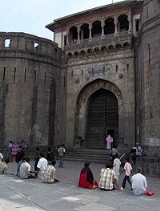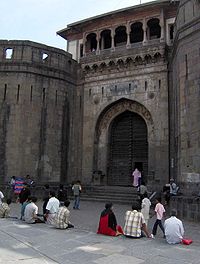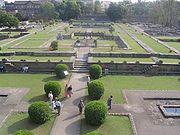
Shaniwar Wada
Encyclopedia

Palace
A palace is a grand residence, especially a royal residence or the home of a head of state or some other high-ranking dignitary, such as a bishop or archbishop. The word itself is derived from the Latin name Palātium, for Palatine Hill, one of the seven hills in Rome. In many parts of Europe, the...
fort in the city of Pune
Pune
Pune , is the eighth largest metropolis in India, the second largest in the state of Maharashtra after Mumbai, and the largest city in the Western Ghats. Once the centre of power of the Maratha Empire, it is situated 560 metres above sea level on the Deccan plateau at the confluence of the Mula ...
in Maharashtra
Maharashtra
Maharashtra is a state located in India. It is the second most populous after Uttar Pradesh and third largest state by area in India...
, India
India
India , officially the Republic of India , is a country in South Asia. It is the seventh-largest country by geographical area, the second-most populous country with over 1.2 billion people, and the most populous democracy in the world...
. Built in 1736, it was the seat of the Peshwa
Peshwa
A Peshwa is the titular equivalent of a modern Prime Minister. Emporer Shivaji created the Peshwa designation in order to more effectively delegate administrative duties during the growth of the Maratha Empire. Prior to 1749, Peshwas held office for 8-9 years and controlled the Maratha army...
rulers of the Maratha Empire
Maratha Empire
The Maratha Empire or the Maratha Confederacy was an Indian imperial power that existed from 1674 to 1818. At its peak, the empire covered much of South Asia, encompassing a territory of over 2.8 million km²....
until 1818 when the Peshwas surrendered to the British. The fort itself was largely destroyed in 1828 by an unexplained fire, but the surviving structures are now maintained as a tourist site.
Construction
Peshwa Baji Rao IBaji Rao I
Shrimant Baji Rao Balaji Bhatt , also known as Baji Rao I, was a noted general who served as Peshwa to the fourth Maratha Chhatrapati Shahu from 1719 until Baji Rao's death. He is also known as Thorale Baji Rao...
, prime minister to Chattrapati Shahu, king of the Maratha empire, laid the ceremonial foundation of his own residence on Saturday, January 10, 1730. It was named Shaniwarwada from the Marathi words Shaniwar (Saturday) and Wada (a general term for any residence complex). Teak
Teak
Teak is the common name for the tropical hardwood tree species Tectona grandis and its wood products. Tectona grandis is native to south and southeast Asia, mainly India, Indonesia, Malaysia, and Burma, but is naturalized and cultivated in many countries, including those in Africa and the...
was imported from the jungles of Junnar
Junnar
Junnar is a city with thousands of years of history in the Pune district of the Indian state of Maharashtra. It is a taluka headquarter. Situated at the base of the Sahyadri mountains, it is around 100 km east of Mumbai and 94 km north of Pune...
, stone was brought from the nearby quarries of Chinchwad, and Lime (mineral)
Lime (mineral)
Lime is a general term for calcium-containing inorganic materials, in which carbonates, oxides and hydroxides predominate. Strictly speaking, lime is calcium oxide or calcium hydroxide. It is also the name for a single mineral of the CaO composition, occurring very rarely...
was brought from the lime-belts of Jejuri
Jejuri
Jejuri is a city and a municipal council in Pune district in the Indian state of Maharashtra. It is famous for the main temple of god Khandoba.-Geography:Jejuri is located at . It has an average elevation of 718 metres ....
. Shaniwarwada was completed in 1732, at a total cost of Rs. 16,110, a very large sum at the time.
The opening ceremony was performed according to Hindu
Hindu
Hindu refers to an identity associated with the philosophical, religious and cultural systems that are indigenous to the Indian subcontinent. As used in the Constitution of India, the word "Hindu" is also attributed to all persons professing any Indian religion...
religious customs, on January 22, 1732, another Saturday chosen for being a particularly auspicious day.
Later the Peshwas made several additions, including the fortification walls, with bastions and gates; court halls and other buildings; fountains and reservoirs. Currently, the perimeter fortification wall has five gateways and nine bastion towers, enclosing a garden complex with the foundations of the original buildings.
It is situated near the Mula-Mutha River
Mula-Mutha River
The Mula-Mutha is a river in India, formed by the confluence of the Mula and Mutha rivers in the city of Pune. It forms a tributary of the Bhima River in the Deccan plateau...
, in Kasba Peth
Kasba Peth
Kasba Peth is the oldest peth in Pune, India and is very adjacent to the historic Shaniwar Wada palace-fort. Kasba Peth was the first Peth to be established somewhere in the 5th century, and is the oldest area in Pune. It is called the "Heart of Pune City."Kasba Ganpati the Gram Daivat of Pune,...
.
Despite its cultural value the fort is not maintained well by the Government. Its inability to maintain the historical Shaniwarwada from the funds provided by central archaeology department forced the fort’s advisory committee’ to woo business houses to fund Shaniwarwada’s makeover.
Gates

- Dilli Darwaza (Delhi Gate), facing north
- The Dilli Darwaza is the main gate of the complex, and faces north towards DelhiDelhiDelhi , officially National Capital Territory of Delhi , is the largest metropolis by area and the second-largest by population in India, next to Mumbai. It is the eighth largest metropolis in the world by population with 16,753,265 inhabitants in the Territory at the 2011 Census...
. Chhatrapati Shahu is said to have considered the north-facing fort a sign of Baji Rao's ambitions against the Mughal empireMughal EmpireThe Mughal Empire , or Mogul Empire in traditional English usage, was an imperial power from the Indian Subcontinent. The Mughal emperors were descendants of the Timurids...
, and suggested that the main gate should be made chhaatiiche, maatiche naahi! (MarathiMarathi languageMarathi is an Indo-Aryan language spoken by the Marathi people of western and central India. It is the official language of the state of Maharashtra. There are over 68 million fluent speakers worldwide. Marathi has the fourth largest number of native speakers in India and is the fifteenth most...
for of the chests of brave soldiers, not mere mud).
- The strongly built Dilli Darwaza gatehouse has massive doors, large enough to admit elephantElephantElephants are large land mammals in two extant genera of the family Elephantidae: Elephas and Loxodonta, with the third genus Mammuthus extinct...
s outfitted with howdahHowdahA howdah, or houdah, also known as hathi howdah, is a carriage which is positioned on the back of an elephant, or occasionally some other animal, used most often in the past to carry wealthy people or for use in hunting or warfare...
s (seating canopies). To discourage elephants charging the gates, each pane of the gate has seventy-two sharp twelve-inch steel spikes arranged in a nine by eight grid, at approximately the height of the forehead of a battle-elephant. Each pane was also fortified with steel cross members, and borders were bolted with steel bolts having sharpened cone heads. The bastions flanking the gatehouse has arrow-loops and machicolationMachicolationA machicolation is a floor opening between the supporting corbels of a battlement, through which stones, or other objects, could be dropped on attackers at the base of a defensive wall. The design was developed in the Middle Ages when the Norman crusaders returned. A machicolated battlement...
chutes through which hot substances could be poured onto offending raiders. The right pane has a small man-sized door for usual entries and exits, too small to allow an army to enter rapidly. Shaniwar Wada was built by contractor from Rajasthan known as 'Kumawat Kshatriya', after completing construction these people well known by name 'Naik'. The name 'Naik' was given to them by Peshwa.
- Even if the main gates were to be forced open, a charging army would need to turn sharply right, then sharply left, to pass through the gateway and into the central complex. This would provide a defending army with another chance to attack the incoming army, and to launch a counterattack to recapture the gateway.
- As the ceremonial gate of the fort, military campaigns would set out from and be received back here, with appropriate religious ceremonies.
- Mastani Darwaja (Mastani's Gate) or Alibahadur Darwaja, facing north
- This gate was used by Bajirao's mistress MastaniMastaniMastani was the wife of Peshwa Baji Rao I , an Indian general and prime minister to the fourth Maratha Chhatrapati Shahuji. She is said to have been a beautiful and brave woman.-Biography:...
while travelling out of the palace's perimeter wall.
- Khidki Darwaja (Window Gate), facing east
- The Khidki Darwaja is named for an armoured window it contains.
- Ganesh Darwaja (Ganesh Gate), facing south-east
- Named for the Ganesh Rang Mahal, which used to stand near this door. It could be used by ladies at the fort to visit the nearby Kasba GanapatiKasba GanapatiThe Kasba Ganapati refers to both a particular idol of the god Ganapati in Pune, India, as well as to the temple built around the idol. The Kasba Ganapati is the presiding deity of Pune....
temple.
- Jambhul Darwaja or Narayan Darwaja (Narayan's Gate), facing south
- This gate was used by concubines to enter and leave the fort. It obtained its second name after Narayan Peshwa's corpse was removed from the fort for cremation through this gate.
Palaces
The important buildings in the palace includes the Thorlya Rayancha Diwankhana (Marathi:The court reception hall of the eldest royal, meaning Baji Rao I), Naachacha Diwankhana (Dance Hall), and Juna Arsa Mahal (Old Mirror Hall).Since the buildings were destroyed in the fire of 1828, only descriptions of the living areas of the fort are available. All the state halls in the buildings are said to have doorways with exquisitely carved teak arches, with ornamental teardrop teak pillars shaped like Suru (cypress
Cupressaceae
The Cupressaceae or cypress family is a conifer family with worldwide distribution. The family includes 27 to 30 genera , which include the junipers and redwoods, with about 130-140 species in total. They are monoecious, subdioecious or dioecious trees and shrubs from 1-116 m tall...
tree) trunks supporting the ceilings, which were covered with beautiful teak tracery, carved creepers and flowers. Exquisite glass chandeliers hung from the ceilings. The floors were made of highly polished marble
Marble
Marble is a metamorphic rock composed of recrystallized carbonate minerals, most commonly calcite or dolomite.Geologists use the term "marble" to refer to metamorphosed limestone; however stonemasons use the term more broadly to encompass unmetamorphosed limestone.Marble is commonly used for...
, arranged in a mosaic
Mosaic
Mosaic is the art of creating images with an assemblage of small pieces of colored glass, stone, or other materials. It may be a technique of decorative art, an aspect of interior decoration, or of cultural and spiritual significance as in a cathedral...
pattern and adorned with rich Persian rug
Persian rug
The Persian carpet is an essential part of Persian art and culture. Carpet-weaving is undoubtedly one of the most distinguished manifestations of Persian culture and art, and dates back to ancient Persia. In 2008, Iran’s exports of hand-woven carpets was $420 million or 30% of the world's market...
s. The walls contained paintings with scenes from the Hindu epics, the Ramayana
Ramayana
The Ramayana is an ancient Sanskrit epic. It is ascribed to the Hindu sage Valmiki and forms an important part of the Hindu canon , considered to be itihāsa. The Ramayana is one of the two great epics of India and Nepal, the other being the Mahabharata...
and the Mahabharata
Mahabharata
The Mahabharata is one of the two major Sanskrit epics of ancient India and Nepal, the other being the Ramayana. The epic is part of itihasa....
.
The buildings are said to have been designed and constructed by many well-known artisans, including Shivaram Krishna, Devaji, Kondaji Sutar, Morarji Patharwat Bhojraja (an inlay-work expert from Jaipur
Jaipur
Jaipur , also popularly known as the Pink City, is the capital and largest city of the Indian state of Rajasthan. Founded on 18 November 1727 by Maharaja Sawai Jai Singh II, the ruler of Amber, the city today has a population of more than 3.1 million....
) and Ragho (a painter
Painting
Painting is the practice of applying paint, pigment, color or other medium to a surface . The application of the medium is commonly applied to the base with a brush but other objects can be used. In art, the term painting describes both the act and the result of the action. However, painting is...
).
One of the buildings in the Shaniwarwada complex was seven storeys high. It is said that the spire of the Sant Dnyaneshwar temple at Alandi
Alandi
Alandi is a city and a municipal council in Pune district in the state of Maharashtra, India.-Geography:Alandi is located on the banks of the Indrayani River, east of Pune, India. It has an average elevation of .-Demographics:...
, 17 km away, could be seen from the uppermost terrace of this building.
The Fountain
The complex had an impressive lotusLotus (plant)
Lotus identifies various plant taxa:* Nelumbo, a genus of aquatic plants with showy flowers** Nelumbo nucifera, the Sacred or Indian lotus** Nelumbo lutea, the American or Yellow lotus...
-shaped fountain: the Hazari Karanje (Fountain of a thousand jets). It was constructed for the pleasure of the infant Peshwa Sawai Madhavrao. It was designed as a sixteen petal lotus; each petal had sixteen jets with an eighty foot arch. It was the most complicated and intricate fountain of its time.
Captain More who visited the Shaniwarwada in 1791 described it as “very magnificent. A hundred dancers can dance here at a time. In one corner is a marble Ganapati statue and the palace is flanked by a fountain and a flower garden.”.
History

In June 1818, the Peshwa
Peshwa
A Peshwa is the titular equivalent of a modern Prime Minister. Emporer Shivaji created the Peshwa designation in order to more effectively delegate administrative duties during the growth of the Maratha Empire. Prior to 1749, Peshwas held office for 8-9 years and controlled the Maratha army...
, Bajirao II, abdicated his Gaadi (throne) to Sir John Malcolm
John Malcolm
Major-general Sir John Malcolm was a Scottish soldier, statesman, and historian-Early life:Born at Burnfoot, Dumfriesshire, Malcolm was the son of George Malcolm, a gentleman farmer of Eskdale and Burnfoot. Jock, as he was then known, was one of the four Malcolm brothers who attained knighthoods...
of the British East India Company
British East India Company
The East India Company was an early English joint-stock company that was formed initially for pursuing trade with the East Indies, but that ended up trading mainly with the Indian subcontinent and China...
and went into political exile at Bithoor
Bithoor
Bithoor is a centre of Hindu pilgrimage in Kanpur District near Kanpur city, in Uttar Pradesh, India.-Location:Bithoor is situated on the Kannauj Road, 27 km from center of Kanpur. Situated on the banks of the Ganges. It is a tourist place....
, near Kanpur in present-day Uttar Pradesh
Uttar Pradesh
Uttar Pradesh abbreviation U.P. , is a state located in the northern part of India. With a population of over 200 million people, it is India's most populous state, as well as the world's most populous sub-national entity...
, India
India
India , officially the Republic of India , is a country in South Asia. It is the seventh-largest country by geographical area, the second-most populous country with over 1.2 billion people, and the most populous democracy in the world...
.
On February 27, 1828, a great fire started inside the palace complex. The conflagration raged for seven days. Only the heavy granite ramparts, strong teak gateways and deep foundations and ruins of the buildings within the fort survived.
Trivia
In 2008, Shaniwar Wada was featured in The Amazing Race Asia 3The Amazing Race Asia 3
The Amazing Race Asia 3 is the third installment of the reality television game show The Amazing Race Asia. The show features ten teams of two, with a pre-existing relationship, in a race around Asia to win US$100,000. The season premiered on September 11, 2008 and consists of 11 episodes, two...
. In the game show, one participant from each team of two have to find the correct pheta
Turban
In English, Turban refers to several types of headwear popularly worn in the Middle East, North Africa, Punjab, Jamaica and Southwest Asia. A commonly used synonym is Pagri, the Indian word for turban.-Styles:...
from among those worn by 50 men within the Wada.

